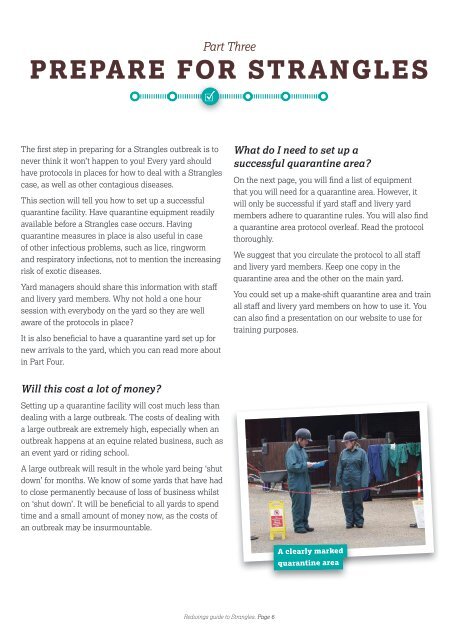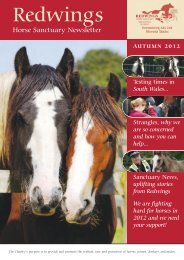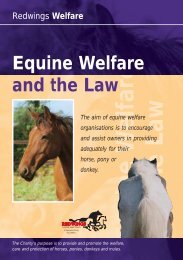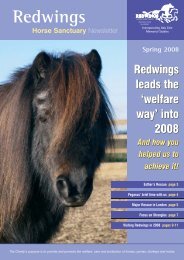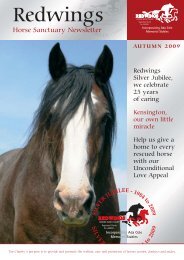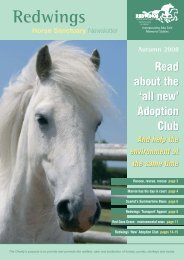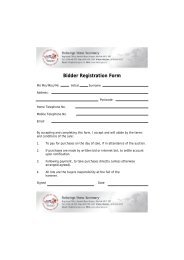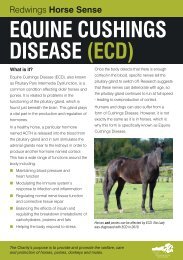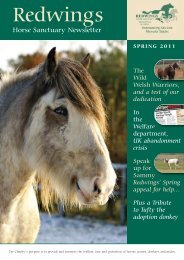STRANGLES - Redwings
STRANGLES - Redwings
STRANGLES - Redwings
Create successful ePaper yourself
Turn your PDF publications into a flip-book with our unique Google optimized e-Paper software.
Part Three<br />
PREPARE FOR <strong>STRANGLES</strong><br />
Foot dip<br />
The first step in preparing for a Strangles outbreak is to<br />
never think it won’t happen to you! Every yard should<br />
have protocols in places for how to deal with a Strangles<br />
case, as well as other contagious diseases.<br />
This section will tell you how to set up a successful<br />
quarantine facility. Have quarantine equipment readily<br />
available before a Strangles case occurs. Having<br />
quarantine measures in place is also useful in case<br />
of other infectious problems, such as lice, ringworm<br />
and respiratory infections, not to mention the increasing<br />
risk of exotic diseases.<br />
Yard managers should share this information with staff<br />
and livery yard members. Why not hold a one hour<br />
session with everybody on the yard so they are well<br />
aware of the protocols in place?<br />
It is also beneficial to have a quarantine yard set up for<br />
new arrivals to the yard, which you can read more about<br />
in Part Four.<br />
Will this cost a lot of money?<br />
Setting up a quarantine facility will cost much less than<br />
dealing with a large outbreak. The costs of dealing with<br />
a large outbreak are extremely high, especially when an<br />
outbreak happens at an equine related business, such as<br />
an event yard or riding school.<br />
A large outbreak will result in the whole yard being ‘shut<br />
down’ for months. We know of some yards that have had<br />
to close permanently because of loss of business whilst<br />
on ‘shut down’. It will be beneficial to all yards to spend<br />
time and a small amount of money now, as the costs of<br />
an outbreak may be insurmountable.<br />
What do I need to set up a<br />
successful quarantine area?<br />
On the next page, you will find a list of equipment<br />
that you will need for a quarantine area. However, it<br />
will only be successful if yard staff and livery yard<br />
members adhere to quarantine rules. You will also find<br />
a quarantine area protocol overleaf. Read the protocol<br />
thoroughly.<br />
We suggest that you circulate the protocol to all staff<br />
and livery yard members. Keep one copy in the<br />
quarantine area and the other on the main yard.<br />
You could set up a make-shift quarantine area and train<br />
all staff and livery yard members on how to use it. You<br />
can also find a presentation on our website to use for<br />
training purposes.<br />
Quarantine set-up checklist<br />
You will need:<br />
- An allocated area away from other horses.<br />
- Cordon tape or a barrier to mark the quarantine area if a case occurs.<br />
This needs to be at least 8ft from the front of the area to allow for<br />
equipment storage. It also needs clearly marked entrance and exit points.<br />
- Signage to mark the quarantine area. You will find example signage<br />
in this pack.<br />
- A separate set of equipment (stable tools, headcollars etc).<br />
Label all equipment “For quarantine use only”.<br />
- Separate storage for feed, forage and bedding. Soft feeds will help<br />
as infected horses will have a sore throat.<br />
- Appropriate disinfectant, such as Safe4. We use Safe4 at <strong>Redwings</strong><br />
because it is non-toxic to animals and humans, and is easy to dispose of.<br />
It is also non-corrosive so it is safe to use when cleaning down equipment.<br />
- Plenty of overalls in different sizes. They must be big enough to cover<br />
neck-collars, shirt-cuffs and trouser-cuffs, otherwise you will easily transfer<br />
the disease onto your own clothes. Overalls must be disinfected and<br />
washed at a high temperature after each use. You can also get<br />
single-use overalls.<br />
- Four bins. Two for foot dip and two to soak used overalls. Place one of<br />
each at the entrance and exit. Both dips must be made up of diluted<br />
disinfectant. See the manufacturer’s instructions for details.<br />
- Two bins with lids. One clearly marked for clean overalls,<br />
and one clearly marked for dirty overalls waiting to be disinfected.<br />
- Spray bottle with diluted disinfectant.<br />
- Disposable gloves.<br />
- Hand wash and/or hand sanitiser specifically for this purpose<br />
(such as Safe4’s hand wash and sanitiser).<br />
- A large number of thick bin bags or old feed bags for muck and<br />
soiled bedding.<br />
A clearly marked<br />
quarantine area<br />
- An area to store muck and soiled bedding. It needs to be disposed<br />
of separately to your normal muck heap.<br />
EVERY piece of equipment in that<br />
area will need to remain there until<br />
quarantine is lifted. If it needs to<br />
be removed at any time it must be<br />
<strong>Redwings</strong> guide to Strangles. Page 6<br />
<strong>Redwings</strong> guide to Strangles. Page 7<br />
thoroughly disinfected first.


